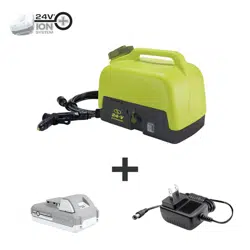Loading ...
Loading ...

3
mWARNING! High-pressure hoses, ttings, and
couplings are important for the safe operation of the appliance.
Use only hoses, ttings, and couplings recommended by the
manufacturer.
mWARNING! Electrical Shock Hazard – Before starting
up your machine, please check it carefully for any defects.
If you nd any, do not start up your machine and contact your
distributor.
IMPORTANT: Only use water without any impurities.
If there is a risk of running sand into the inlet water (i.e. from
your own well), an additional lter should be installed.
mWARNING! Do not ll any other liquid except clean
water in the water tank.
• Check for damaged parts – Do not use the appliance if
any important part of the appliance are damaged
(e.g. safety devices, hoses, spray nozzle).
• This cordless spray washer must not be used at
temperatures below 32ºF (0°C).
• Keep the machine on a stable, at surface during operation,
handling, transportation, and storage.
• In the event of an accident or breakdown, switch o the
machine immediately.
Electrical Safety
1. If the battery charger cord is damaged, please call the
Snow Joe
®
+ Sun Joe
®
customer service center at
1-866-SNOWJOE (1-866-766-9563).
2. If charging the power tool in a damp location is
unavoidable, use a residual current device (RCD)
protected power supply. The using of an RCD reduces the
risk of electric shock.
3.
Do not abuse the charging cord. Never use the cord for
carrying, pulling or unplugging the charger. Keep cord away
from heat, oil, sharp edges or moving parts. Damaged or
entangled cords increase the risk of electric shock.
4. Battery charger is for indoor use only. Do not charge the
spray washer in rain, or in wet locations.
Battery & Charger
Safety Instructions
We pay a great deal of attention to the design of every battery
pack to ensure that we supply you with batteries that are safe,
durable and have a high energy density. The battery cells have
a wide range of safety devices. Each individual cell is initially
formatted and its electrical characteristic curves are recorded.
This data is then used exclusively to be able to assemble the
best possible battery packs.
Despite all the safety precautions, caution must always be
exercised when handling batteries. The following points must
be obeyed at all times to ensure safe use. Safe use can only
be guaranteed if undamaged cells are used. Incorrect handling
of the battery pack can cause cell damage.
IMPORTANT! Analyses conrm that incorrect use and poor
care of high-performance batteries are the main factors
responsible for personal and/or product damage.
mWARNING! Use only approved Use only approved
replacement batteries; other batteries may damage the power
tool and cause it to malfunction, which can lead to serious
personal injury.
mWARNING! Do not use a battery pack or appliance that
is damaged or modied. Damaged or modied batteries may
exhibit unpredictable behavior resulting in re, explosion or risk
of injury.
Do not modify or attempt to repair the appliance or the battery
pack except as indicated in the instructions for use and care.
Have your battery pack serviced by a qualied repair person
using only identical replacement parts. This will ensure that the
safety of the battery pack is maintained.
mCAUTION! To reduce the risk of injury, charge the
iON+ 24V lithium-ion battery pack only in its designated
iON+ 24V lithium-ion charger. Other types of chargers present
risk of re, personal injury and damage. Do not wire a battery
pack to a power supply plug or car cigarette lighter. Such
misuse will permanently disable or damage the battery pack.
• Avoid dangerous environments – Do not charge the
battery pack in rain, snow or in damp or wet locations.
Do not use the battery pack or charger in the presence of
explosive atmospheres (gaseous fumes, dust or ammable
materials) because sparks may be generated when inserting
or removing the battery pack, which could lead to a re.
• Charge in a well-ventilated area – Do not block the
charger vents. Keep them clear to allow for proper
ventilation. Do not allow smoking or open ames near a
charging battery pack. Vented gases may explode.
NOTE: The safe temperature range for the battery is
41°F (5°C) to 105°F (40.5°C). Do not charge the battery
outside in freezing weather; charge it at room temperature.
• Maintain charger cord – When unplugging the charger, pull
the plug, not the cord, from the receptacle to reduce the
risk of damage to the electrical plug and cord. Never carry
the charger by its cord or yank it by the cord to disconnect
it from the receptacle. Keep the cord away from heat, oil
and sharp edges. Make sure the cord will not be stepped
on, tripped over or subjected to damage or stress when the
charger is in use. Do not use the charger with a damaged
cord or plug. Replace a damaged charger immediately.
Loading ...
Loading ...
Loading ...
